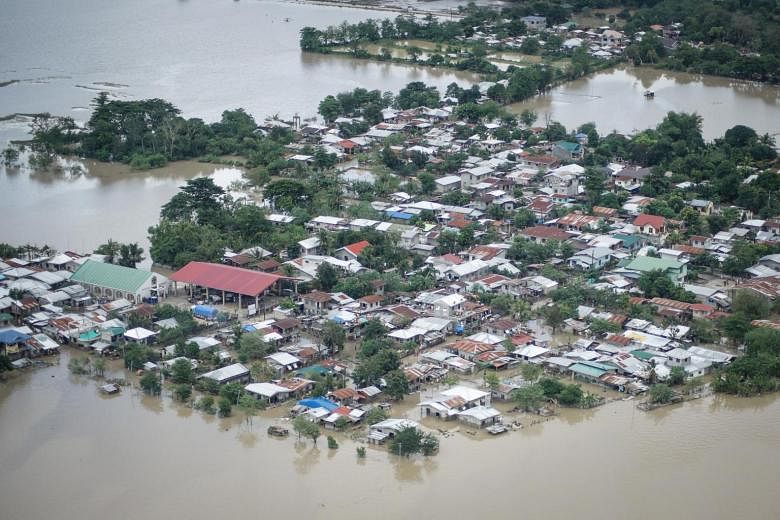In the article, the paper calls for a mindset change to reduce the consequences of future natural disasters
MANILA (PHILIPPINE DAILY INQUIRER/ASIA NEWS NETWORK) - Barely had the nation wrapped its head around the havoc wrought by Typhoon "Ulysses" in Marikina City, the province of Rizal, and others adjacent to Metro Manila than another devastation was revealed: flooding in the provinces of Cagayan and Isabela that's the "worst in memory" in 45 years, according to Cagayan Gov. Manuel Mamba.
It was only late Friday and early Saturday that the general public was apprised of what was happening in Cagayan Valley.
The initial information came mainly from social media, in the form of cries for help from residents trapped in their homes and panicked by the powerful flood surge.
Despite its budget of P1.698 billion (S$47.24 million) for 2020, up from P1.4 billion in 2019, the the Presidential Communications Operations Office (PCOO), was unable to rise to the challenge of crisis reporting so vital to this disaster-tossed archipelago.
Communications Secretary Martin Andanar, pleased by the boosted budget, was quoted in 2019 as promising to "improve the quality of our reporting in PTV, also in Radyo Pilipinas, as well as in the Philippine News Agency - including the News and Information Bureau, the Bureau of Communications Services, and other branches of the PCOO."
The broadcast vacuum was obvious and palpable.
Its franchise killed by the House of Representatives, the giant network ABS-CBN had been forced to close its regional bureaus, depriving not only the residents of Cagayan Valley but also the general public of critical information.
But past midnight of Friday its TeleRadyo managed to reach Governor Mamba, who said Cagayan River had breached its banks because of the overflow of rainwater from nearby Isabela, Nueva Vizcaya, Quirino, Ifugao, and Kalinga, "exacerbated" by the release of excess water from Magat Dam in Isabela.
By Sunday a horrific picture of the water world in Cagayan and Isabela had emerged, once more galvanising the private sector to engage in rescue and relief efforts for those made desolate and now afflicted by hunger and thirst.
It doesn't take much prodding for private citizens and groups to put their shoulder to the wheel of collective relief action, and Communications Undersecretary Lorraine Badoy's perverse itch to smear certain such persons and groups as "red" and therefore to be hounded and prosecuted is a gross disservice that taints the title she holds. They have exhibited the capability and competence to extend a helping hand, as well as the compassion so urgently needed in this year of constant suffering: from the eruption of Taal Volcano in January to the ongoing Covid-19 pandemic that has claimed thousands of lives, ruined businesses, and reduced many of the unemployed to begging in the streets, to this season of weather disturbances so severe that those directly hit, like the residents of Catanduanes and other Bicol provinces, are pummelled yet again even before they can totter back to their feet from an earlier beating.
But Cagayan and Isabela were not directly hit by Ulysses and Typhoon "Rolly," the strongest in the world this year.
The torrential rains brought by these and other typhoons and an enhanced monsoon, as well as huge volumes of water released from Magat Dam, caused the Cagayan River and its tributaries to swell, unleashing floodwaters that rose to an "unprecedented" 13.1 meters.
On Facebook, Mayor Cristina Antonio of the hard-hit town of Alcala wrote of how in 2019 her local government turned to science to address the perennial floods.
It consulted the marine geologist Dr Fernando Siringan, who, along with his fellow UP geologist Keanu Jershon Sarmiento, proceeded to study the Cagayan and Pared Rivers in Alcala, their depth and meander, as well as the lay of the land including the rocks, banks, vegetation, and communities impacted.
The study that took place only last July-September turned up, among other things, the fine and terrible details of what is generally known - the dire effects of deforestation, especially in Cagayan Valley - and also the necessity of far-reaching change through science-based methods and solutions, change more enduring than what the graft-prone dredging and dike-building that usually occur after a deluge can bring about.
"My insight," wrote Mayor Antonio, "is that the problem of flood in Alcala and Cagayan Valley cannot be attributed to just one cause outside of us, but to a complex, interrelated web with us right at the center."
Thus, Alcala farmers are shifting to agroforestry and have begun planting native trees in the watersheds that add up to 300 hectares.
The townsfolk have been engaged to plant "tiny, dense native forests" in all 25 barangays.
"It's not just about Magat Dam protocols, although in our state of despair, Magat Dam is the most visible target," Antonio wrote.
It's about the destruction of forests, mountain slopes, watersheds, even the soil.
A mindset - "as if we are apart from nature, as if what we do does not come back to us" - that requires a radical overhaul.
The paper is a member of The Straits Times media partner, the Asia News Network, an alliance of 24 news media titles.

